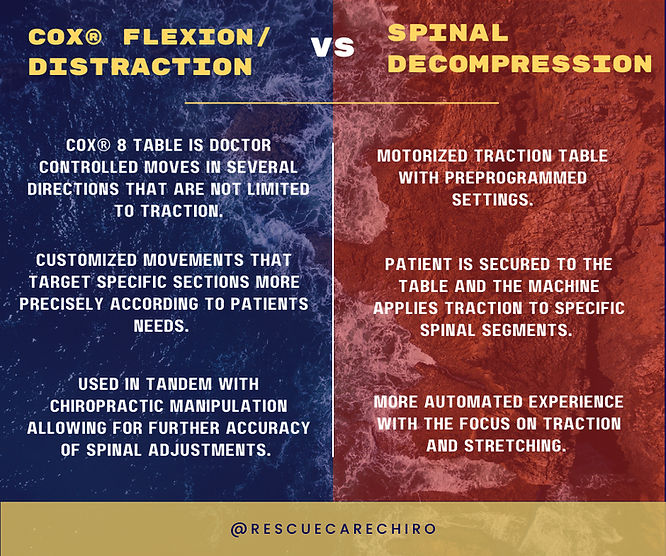
What is the Cox ® Technic ?
Cox® Flexion Distraction: highly specified hands-on spinal decompression performed by a certified physician. Invented and taught by Dr. James Cox. Named after its developer, James M. Cox DC DACBR, Cox®
The Treatment: Involves the use of the Cox® 8 table that can be flexed and extended in a controlled manner. During a Cox Flexion-Distraction treatment, the patient lies face down on the table, and the chiropractor applies gentle, rhythmic movements to the spine. These movements include a combination of flexion (forward bending) and distraction (gentle pulling apart) of the spinal segments. This allows more blood flow and space for spinal nutrients to flow enabling healing and pain relief.
The goal: of this technique is to alleviate pain, reduce pressure on spinal discs, and improve spinal mobility.

The Cox® 8 Table
The Cox® 8 table is the preferred adjusting tool at Rescue Care Chiropractic New Smyrna Beach Spine Clinic. The flexion/ Distraction table in addition to long Y axis traction enables a gentile expansion of the vertebrae, dropping intradiscal pressure. This opening of the spinal canal allows nutrients to flow back into the spine that will increase healing time and improve range of motion. Allowing greater accuracy from the manual adjustment performed by a Cox® certified physician.

The Difference
Cox Flexion Distraction VS

CONDITION SPECIFIC CARE

Neck Pain
Headaches
Mid Back Pain
Low Back Pain
Neuropathy
Radiating Pain
Cox Flexion-Distraction is often used to treat conditions such as:
-
Disc herniation or bulging discs: The gentle traction and flexion movements can help reduce pressure on the spinal discs and relieve associated pain and discomfort.
-
Sciatica: This technique can help alleviate the symptoms of sciatica, which is often caused by compression or irritation of the sciatic nerve.
-
Spinal stenosis: By creating space between spinal segments, Cox Flexion-Distraction can potentially relieve symptoms of spinal stenosis, a condition where the spinal canal narrows and puts pressure on the spinal cord and nerves.
-
Spondylolisthesis: This is a condition where one vertebral body slips forward or backward in relation to the adjacent vertebra. The flexion-distraction technique can help alleviate symptoms associated with this condition.
-
General lower back pain: The gentle stretching and mobilization of the spine can provide relief from non-specific lower back pain.

